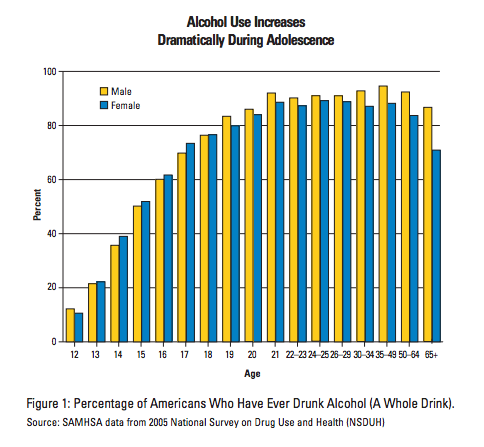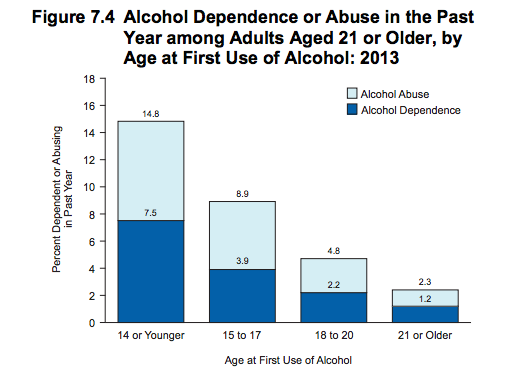Can I See Your ID?
Underage drinking has always been an important topic of discussion because it has had negative impacts on too many lives. The United States is one of the twelve countries that is 21 age restricted while the vast majority of the other countries range from 16 to 19 years of age. Only 6% of all countries have an age restriction of 21 years. (ProCon) So that leaves the big question, if the majority of the world is drinking at 18 then why is the United States waiting till they are 21? Scientists, politicians, parents, teachers, and teenagers are all trying to figure out what the right decision is when it comes to alcohol.
Maybe A Lower Age Limit Could Work?
The organization Monitoring The Future is focused on the ongoing behaviors and values of American students. They survey about 50,000 8th, 10th, and 12th grade students every year. These surveys have been ongoing since 1975 and include follow up surveys. In 2014, they found that trends of these students having 5 or more drinks in a row in two weeks were declining. The disapproval of having that much to drink was rising among these 8th, 10th, and 12th graders. These trends were very similar to students drinking alcohol in a span of 30 days. Even though high school students are marginally more disapproving of having 5 drinks in a row, “more than 90% of high school seniors claim that alcohol is “fairly easy” or “very easy” to obtain, and nearly half have admitted to drinking in the past 30 days” (SSDP). It is easy to see that there is some factor that is influencing these high school students to care less for binge drinking even though more than 90% of them have easy access to it. Campaigns that are out there to lower the age limit tend to focus on states enacting “policies that they believe will reduce the overall harm of alcohol use” (SSDP). Maybe lowering the minimum age will encourage responsibility in the youth but science has shown the harm that can come with drinking at a young age.
Parents and Peers
Family and community are important with preventing underage drinking. Peer pressure plays a large role in the lives of many adolescents and unless adolescents have the proper knowledge and attitude toward underage alcohol use, adolescents would see “the social acceptability of drinking encourage the adolescent to begin and continue drinking” (Alcohol Alert). Parent-child relationships and discipline have a significant influence on an adolescents alcohol use. According to the NHTSA Traffic Safety Facts, 4,242 lives were saved from 2004 to 2008 because of the minimum drinking age law. The organization Monitoring The Future has shown that disapproval of drinking among 8th, 10th, and 12th graders was rising and that they were caring less and less about drinking. If parents and communities were to monitor their kids more closely and implement more educational programs in school, there would be less alcohol related accidents and more lives saved.
Alcohol and The Brain
As adolescents are transitioning between childhood and adulthood, the changes that are happening with the body and brain can be easily influenced by the activities and risks that are taken. According to the National Institute on Alcohol Abuse and Alcoholism, “exposing the brain to alcohol during this period may interrupt key processes of brain development, possibly leading to mild cognitive impairment as well as to further escalation of drinking” (Alcohol Alert). The hippocampus, located in the temporal lobe, is associated with memory and also helps with regulating emotions. If an adolescent beings drinking before they are 21- lets say at 15 because that is the age where about 50% of boys and girls have had drink- the hippocampus would be proportionally smaller.
In a hippocampal volume study done by Michael Bellis, it was found that “adolescents and young adults with adolescent-onset alcohol use disorders were found to have significantly smaller left and right hippocampal volumes than healthy matched comparison subjects”. The smaller hippocampi could be as a result of the alcohol impairing the growth and development of the hippocampus. In a neurocognitive functioning study conducted on adolescents, it was found that the “alcohol–dependent youth had greater difficulty remembering words and simple geometric designs after a 10–minute interval”. These studies show the correlation between adolescent-onset alcohol use and the effects it has on the brain and how these effects could alter their educational success down the road. In a study done by Yvette Sheline, she found that the volume of the hippocampus correlated with vulnerability to stress and depression. Her study excluded patients with substance abuse because alcohol dependence can cause cerebral atrophy, but the theory that people with smaller hippocampi are more vulnerable to depression could correlate to drinking as an adolescent. This would be an interesting study to conduct and if significant correlations were found, it could answer many questions about depression.
In Conclusion
Drinking habits can be shaped by the influence of environments, parents, and peers. There are public policy measures that are taken to prevent underage drinking, but the most effective strategy for prevention is education. According to the Young Drivers Traffic Safety Facts, “the 21-year-old minimum drinking age laws have reduced traffic fatalities involving drivers 18 to 20 years old by 12 percent and have saved an estimated 27,052 lives since 1975”. The influence of family and alcohol education can help reduce traffic fatalities and save more lives. Lowering the 21-age restriction will not help adolescents stay away from alcohol. These delicate brains need the structure from society, school, and from their families to know that drinking at a young age can lead to alcohol dependence or abuse. As shown in the graph above, adults who started drinking at 14 or younger were more likely to become alcohol dependent or to abuse alcohol compared to those who started drinking at or after 21 years old. (NSDUH 2013) The long-term risks that are associated with adolescent alcohol use are not worth lowering the minimum age below 21.
Works Cited
Bellis, M. (2000). Hippocampal Volume in Adolescent-Onset Alcohol Use Disorders. American Journal of Psychiatry, 737-744. Retrieved August 1, 2015, from ProQuest.
Brown, S., Tapert, S., Granholm, E., & Delis, D. (2000). Neurocognitive Functioning of Adolescents: Effects of Protracted Alcohol Use. Alcoholism: Clinical and Experimental Research, 164-171. Retrieved July 2015, from PubMed.
Johnston, L. D., Miech, R. A., O’Malley, P. M., Bachman, J. G., & Schulenberg, J. E. (December 16, 2014). “Use of alcohol, cigarettes, and number of illicit drugs declines among U.S. teens.” University of Michigan News Service: Ann Arbor, MI. from http://www.monitoringthefuture.org
Lives Saved in 2008 by Restraint Use And Minimum Drinking Age Laws. (2010). In Traffic Safety Facts. Washington, DC: U.S. Dept. of Transportation, National Highway Traffic Safety Administration.
Lowering the Drinking Age. (n.d.). Retrieved August 2015, from http://ssdp.org/campaigns/lowering-drinking-age/
Minimum Legal Drinking Age (MLDA) in 190 Countries – Minimum Legal Drinking Age – ProCon.org. (2015, July 24). Retrieved July 2015.
Sheline, Y. (1996). Hippocampal atrophy in recurrent major depression. Proceedings of the National Academy of Sciences, 3908-3913.
Substance Abuse and Mental Health Services Administration (SAMHSA). Results From the 2005 National Survey on Drug Use and Health: National Findings, NSDUH Series H–30, DHHS Pub. No. SMA 06–4194. Rockville, MD: SAMHSA, Office of Applied Studies, 2006.
Substance Abuse and Mental Health Services Administration, Results from the 2013 National
Survey on Drug Use and Health: Summary of National Findings, NSDUH Series H-48, HHS
Publication No. (SMA) 14-4863. Rockville, MD: Substance Abuse and Mental Health Services
Administration, 2014.
The Surgeon General’s Call to Action to Prevent and Reduce Underage Drinking, 2007. (n.d.). Retrieved July 2015, from http://www.camy.org/factsheets/sheets/alcohol_advertising_promotion/Call_To_Action.pdf
Underage Drinking: A Major Public Health Challenge — Alcohol Alert No. 59. (2003, April 1). Retrieved August 1, 2015, from http://pubs.niaaa.nih.gov/publications/aa59.htm
Young Drivers. (n.d.). In Traffic Safety Facts (pp. 2-6). Washington, DC: U.S. Dept. of Transportation, National Highway Traffic Safety Administration.


